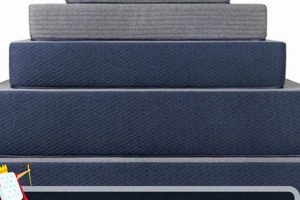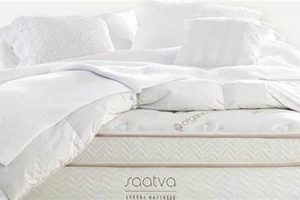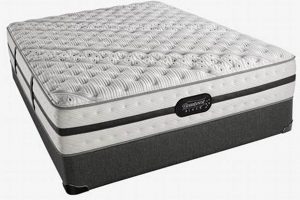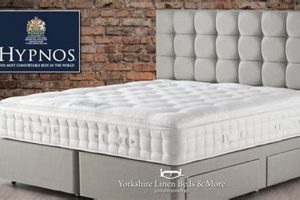A superior sleep surface incorporating gel-infused materials represents a significant advancement in mattress technology. These mattresses are designed to provide enhanced comfort and temperature regulation compared to traditional innerspring or memory foam options. The integration of gel, typically within a foam layer, aims to dissipate heat and contour to the body, offering a potentially more restful sleep experience.
The primary advantage lies in improved thermal management. Gel possesses inherent cooling properties, mitigating the common issue of heat retention often associated with conventional foam mattresses. This characteristic can be particularly beneficial for individuals who tend to overheat during sleep. Historically, the development of these sleep surfaces arose from the need for more comfortable and supportive bedding, addressing concerns related to pressure points and inadequate ventilation.
Therefore, understanding the construction, properties, and variations within gel-infused mattress designs is crucial when evaluating options for optimizing sleep quality and overall well-being. Subsequent sections will delve into specific types, materials, and considerations relevant to selecting a suitable sleep solution.
Selecting an Optimal Gel-Infused Mattress
The following guidelines offer practical advice for discerning consumers seeking a gel-infused mattress that aligns with individual needs and preferences.
Tip 1: Evaluate Density and ILD Ratings: Higher density in the foam layers typically correlates with increased durability and support. Indentation Load Deflection (ILD) ratings indicate firmness; a lower ILD suggests a softer feel, while a higher ILD indicates greater firmness. Select ratings appropriate for the user’s body weight and preferred sleeping position.
Tip 2: Scrutinize Gel Infusion Technique: Gel can be infused as beads, swirls, or layers. Bead infusions may provide localized cooling, while layered infusions offer more uniform temperature regulation. Consider the extent of gel coverage and its distribution within the mattress layers.
Tip 3: Consider the Mattress Construction: Analyze the composition of the entire mattress, not solely the gel-infused layer. The base support layer (e.g., high-density foam or innersprings) significantly impacts overall support and longevity. A well-constructed mattress will offer balanced support and pressure relief.
Tip 4: Inquire About Certifications: Look for certifications such as CertiPUR-US, which ensures the foam has been tested for harmful chemicals, VOC emissions, and other environmental factors. Certifications provide assurance regarding product safety and quality.
Tip 5: Assess Edge Support: Adequate edge support prevents sagging and maximizes the usable sleep surface. Strengthened edges are particularly important for individuals who sleep near the edge of the bed or require assistance getting in and out.
Tip 6: Understand the Trial Period and Warranty: A generous trial period allows for a thorough assessment of the mattress’s suitability. Review the warranty terms carefully, noting the coverage duration and any exclusions.
Tip 7: Research Breathability Enhancements: Beyond gel infusion, some mattresses incorporate features like open-cell foam or breathable covers to further improve airflow and temperature regulation. Evaluate these additional features based on individual climate and comfort preferences.
By carefully considering these factors, individuals can make informed decisions regarding gel-infused mattress purchases. Focusing on material quality, construction, and individual needs will increase the likelihood of selecting a sleep surface that delivers optimal comfort, support, and temperature management.
The subsequent analysis will address common misconceptions and potential drawbacks associated with gel-infused mattresses.
1. Temperature regulation
Temperature regulation stands as a pivotal factor in determining the suitability of a sleep surface. Its connection to the concept of a desirable gel mattress directly influences user comfort and sleep quality. The integration of gel-infused materials aims to address the pervasive issue of heat retention often associated with conventional mattress constructions.
- Gel’s Conductive Properties
Gel, as a material, exhibits enhanced thermal conductivity compared to traditional memory foam. This inherent property allows it to draw heat away from the sleeper’s body, promoting a cooler sleep environment. In practice, mattresses utilizing gel infusions often demonstrate a measurable reduction in surface temperature compared to those without, especially during extended periods of contact.
- Open-Cell Foam Integration
The efficacy of gel-infused materials is often amplified when combined with open-cell foam structures. Open-cell foam facilitates greater airflow within the mattress, further dissipating heat and moisture. This synergistic effect contributes to a more balanced and consistent sleep temperature, mitigating the build-up of trapped body heat.
- Phase Change Materials (PCMs)
Some advanced gel-infused mattresses incorporate Phase Change Materials (PCMs). PCMs absorb and release heat as they transition between solid and liquid states, providing a dynamic temperature regulation system. This technology allows the mattress to actively adapt to changing body temperatures throughout the night, maintaining a comfortable thermal environment.
- Cover Fabric Breathability
The outer cover fabric plays a crucial role in overall temperature management. Breathable fabrics, such as those derived from natural fibers like cotton or Tencel, promote airflow and prevent moisture accumulation. This feature complements the cooling properties of the gel-infused layer, enhancing the mattress’s ability to regulate temperature effectively.
The cumulative effect of these temperature regulation strategies significantly impacts the overall sleep experience. By effectively managing heat and moisture, a gel-infused mattress can mitigate sleep disturbances caused by overheating, contributing to improved sleep quality and a more restful night.
2. Pressure relief
Effective pressure relief represents a critical determinant of sleep quality and is a fundamental attribute sought in a mattress. Gel-infused mattresses are engineered, in part, to address this specific need. The conforming nature of the gel-infused foam allows it to distribute weight more evenly across the sleeping surface, thereby reducing concentrated pressure on prominent body parts such as the shoulders, hips, and knees. This redistribution mitigates the potential for localized discomfort and circulatory restriction that can disrupt sleep cycles.
The effectiveness of press
ure relief in a mattress can be quantified through various biomechanical assessments measuring interface pressure between the body and the sleep surface. Mattresses exhibiting lower peak pressure values at these critical contact points are generally considered to provide superior pressure relief. Consider, for instance, an individual with chronic hip pain. A gel-infused mattress, by conforming to the contours of the hip and distributing weight more effectively, may alleviate pain and discomfort, facilitating a more restful sleep experience. Conversely, a mattress lacking adequate pressure relief may exacerbate these pre-existing conditions, leading to sleep disturbances and daytime fatigue.
In summary, the connection between gel-infused materials and pressure relief is rooted in the material’s inherent properties and its ability to contour to the body. The extent of pressure relief offered by a specific mattress is contingent upon factors such as the density and composition of the gel-infused foam, as well as the overall construction of the mattress. Understanding this relationship is crucial for consumers seeking a sleep surface that addresses their individual needs and promotes restorative sleep by minimizing pressure-related discomfort.
3. Supportive core
The supportive core of a mattress constitutes the foundation upon which comfort and durability are built. In the context of a gel mattress, the core’s role is paramount in determining its overall performance and longevity. The gel-infused layers, responsible for temperature regulation and pressure relief, are reliant on the underlying core for stable support and proper spinal alignment. Without an adequately supportive core, the benefits of the gel infusion are compromised, potentially leading to sagging, uneven weight distribution, and diminished sleep quality. For example, a gel memory foam layer placed atop a weak, innerspring core is likely to exhibit premature wear and provide inadequate support over time, negating the advantages of the gel’s cooling and conforming properties.
The composition of the supportive core varies, encompassing options such as high-density foam, pocketed coils, or a hybrid combination of both. High-density foam cores provide uniform support and are often utilized in all-foam mattresses, while pocketed coil systems offer targeted support and enhanced motion isolation. The selection of core material should be predicated on individual needs and preferences, considering factors like body weight, sleep position, and sensitivity to motion transfer. A heavier individual, for instance, may benefit from a coil-based core that provides enhanced support and prevents excessive sinking, whereas a lighter individual may find sufficient support in a high-density foam core.
In conclusion, the supportive core is an indispensable element of a gel mattress, directly influencing its comfort, durability, and ability to promote restful sleep. Understanding the properties and characteristics of different core materials enables informed decision-making, ensuring that the gel-infused layers are complemented by a foundation that provides optimal support and prolongs the lifespan of the mattress. Neglecting the significance of the supportive core undermines the potential benefits of a gel mattress and may result in a less-than-satisfactory sleep experience.
4. Edge support
Edge support significantly contributes to the overall quality and usability of a mattress, especially when considering gel-infused models. The perimeter of a mattress often experiences concentrated pressure from individuals sitting on the edge or utilizing the full surface area during sleep. Inadequate edge support results in compression and sagging, reducing the effective sleeping area and potentially compromising the long-term structural integrity of the mattress. A gel mattress with weak edge support, for example, may exhibit noticeable dipping along the sides after a relatively short period of use, particularly if an individual frequently sits on the edge to dress or read. This sagging not only diminishes comfort but also reduces the overall support provided, potentially leading to discomfort and postural issues.
The integration of reinforced edge support systems mitigates these issues. These systems typically involve high-density foam rails or strategically placed coils around the perimeter of the mattress, designed to withstand greater pressure and prevent compression. The presence of robust edge support is particularly crucial in gel mattresses due to the inherent softness and conforming nature of the gel-infused foam. Without sufficient reinforcement, the edges are more susceptible to deformation under pressure. As an example, consider two otherwise identical gel mattresses, one with reinforced edges and one without. Over time, the mattress with reinforced edges will maintain its shape and provide consistent support across the entire surface, while the mattress lacking this feature will likely exhibit significant sagging and reduced edge usability.
In summary, edge support is an integral component of a high-quality gel mattress. It enhances the usability of the sleeping surface, prolongs the lifespan of the mattress, and contributes to overall comfort and support. Assessing the quality of edge support is therefore essential when evaluating gel mattress options, as it directly impacts the long-term value and satisfaction derived from the product. The presence of reinforced edges signifies a commitment to durability and usability, ensuring that the mattress provides consistent support across its entire surface area throughout its lifespan.
5. Material density
Material density, quantified as mass per unit volume, exerts a considerable influence on the performance and longevity of gel-infused mattresses. Higher density in foam layers, for example, generally correlates with increased durability, resistance to compression, and enhanced support. A mattress employing low-density foam may exhibit premature sagging and a diminished capacity to maintain proper spinal alignment, thereby compromising comfort and potentially exacerbating musculoskeletal issues. In contrast, a mattress incorporating high-density foam provides more consistent support and is less prone to deformation over prolonged use. Consider two gel-infused mattresses: one utilizing 2.0 lb/ft density foam and the other employing 4.0 lb/ft density foam. The latter will demonstrably exhibit superior resistance to body impressions and provide a more stable sleeping surface over an extended period.
The gel infusion itself is also subject to density considerations. While the primary function of the gel is temperature regulation, its integration within the foam matrix affects the overall density and firmness characteristics of the material. The optimal concentration of gel, therefore, requires a balance between thermal properties and structural integrity. Excessive gel infusion may compromise the foam’s inherent support capabilities, while insufficient gel integration may fail to provide adequate cooling benefits. Furthermore, variations in density within different layers of the mattress are often deliberately engineered to achieve specific performance characteristics. For instance, a high-density support core may be combined with a lower-density
comfort layer to optimize both support and pressure relief. This approach necessitates careful selection and matching of materials to ensure cohesive performance and prevent premature failure due to differential deformation.
In summation, material density is a critical, albeit often overlooked, attribute of gel-infused mattresses. Its influence extends beyond simple durability to encompass support, comfort, and the overall effectiveness of the gel infusion. While higher density generally equates to improved performance, the optimal density varies depending on the specific application and the interplay with other mattress components. A thorough understanding of material density enables informed decision-making, allowing consumers to select a gel-infused mattress that delivers sustained comfort, support, and long-term value. Challenges remain in consistently quantifying and communicating density information to consumers in a transparent and accessible manner, underscoring the need for standardized testing and labeling practices within the mattress industry.
6. Firmness level
Firmness level, representing the perceived rigidity of a sleep surface, fundamentally influences the suitability of any mattress, including those incorporating gel-infused materials. The connection between firmness and a mattress’s capacity to provide optimal comfort and support is direct and significant. A firmness level misaligned with an individual’s physiological needs and sleep preferences can negate the potential benefits of gel infusion, leading to discomfort, disrupted sleep, and even musculoskeletal strain. For example, a side sleeper requiring significant pressure relief at the shoulders and hips would likely find a firm mattress, regardless of its gel infusion, to be unsatisfactory. Conversely, a stomach sleeper requiring ample spinal support might find a plush mattress to be equally unsuitable.
The impact of firmness extends beyond immediate comfort. An inappropriate firmness level can contribute to poor spinal alignment, leading to chronic back pain and other health complications. A mattress that is too soft may allow the spine to curve excessively, while a mattress that is too firm may fail to adequately conform to the body’s natural contours, resulting in pressure points and discomfort. These long-term effects highlight the importance of selecting a firmness level that aligns with one’s body weight, sleeping position, and any pre-existing health conditions. Mattress manufacturers typically categorize firmness on a scale, often ranging from “extra plush” to “extra firm,” providing a framework for consumers to assess their preferences. However, subjective perception of firmness can vary, necessitating in-person testing or careful consideration of customer reviews.
In summary, firmness level is an indispensable characteristic to consider when evaluating a gel mattress. Its alignment with individual needs directly impacts comfort, spinal health, and overall sleep quality. While gel infusion offers specific advantages related to temperature regulation and pressure relief, these benefits are contingent upon selecting an appropriate firmness level. Navigating the complexities of firmness requires careful consideration of personal preferences, body characteristics, and the potential long-term health implications of an unsuitable sleep surface. The industry’s ongoing efforts to standardize firmness ratings and improve consumer education remain crucial in facilitating informed mattress selection and promoting restful, restorative sleep.
7. Longevity
The lifespan of a mattress represents a crucial factor in evaluating its overall value proposition. For a gel-infused mattress to be considered a sound investment, it must demonstrate durability and maintain its key performance characteristics, such as temperature regulation, pressure relief, and support, over an extended period. Premature degradation of materials or a significant decline in performance undermines the initial appeal of the gel infusion and ultimately diminishes the mattress’s long-term utility. For instance, a gel memory foam mattress that initially provides excellent cooling and contouring but loses its shape and support within a few years due to low-density foam construction cannot be classified as a high-quality, or “best,” option. The relationship between initial cost and expected lifespan is a critical determinant of true value.
The factors contributing to a gel mattress’s longevity are multifaceted, encompassing material selection, manufacturing processes, and usage patterns. High-density foams, robust support cores (e.g., pocketed coils or high-density base foam), and reinforced edge support systems all play a critical role in preventing premature sagging and maintaining structural integrity. Furthermore, the quality and distribution of the gel infusion influence its long-term effectiveness. Over time, poorly integrated gel particles may migrate or degrade, diminishing their cooling capacity. Consider the example of two similar mattresses: one constructed with high-quality, CertiPUR-US certified foams and a durable coil system, and another utilizing cheaper, lower-density materials. The former will invariably exhibit a longer lifespan and retain its performance characteristics more effectively. Usage patterns, such as rotating the mattress regularly and using a supportive bed frame, also contribute to its longevity.
In conclusion, longevity is an indispensable attribute of a superior gel mattress. A mattress that provides exceptional initial comfort but fails to maintain its performance characteristics over time represents a poor investment. The longevity of a gel mattress is determined by a confluence of factors, including material quality, construction techniques, and user care. Understanding these factors allows consumers to make informed purchasing decisions and select a gel-infused mattress that delivers lasting comfort, support, and value. The challenge for the mattress industry lies in transparently communicating these factors to consumers and providing verifiable data regarding product durability and expected lifespan.
Frequently Asked Questions
The following section addresses common inquiries and misconceptions surrounding gel-infused mattresses, providing factual information to assist in informed decision-making.
Question 1: How does a gel mattress regulate temperature?
Gel-infused materials possess inherently higher thermal conductivity compared to traditional memory foam. This property facilitates the dissipation of heat away from the sleeper’s body, creating a cooler sleep environment. Some mattresses also incorporate open-cell foam structures to further enhance airflow and temperature regulation.
Question 2: Are gel mattresses suitable for individuals with back pain?
The suitability of a gel mattress for individuals with back pain depends on several factors, including the firmness level, support core, and individual preferences. A mattress that provides adequate spinal alignment and pressure relief is generally recommended. Consulting with a healthcare professional is advisable for personalized recommendations.
Question 3: What is the expected lifespan of a gel mattress?
The lifespan of a gel mattress varies depending on material quality, construction, and usage patterns. A high-quality gel mattress constructed with durable materials and a robust support core can last for 7-10 years or longer. Regu
lar rotation and proper bed frame support can also contribute to longevity.
Question 4: Are there any potential drawbacks to gel mattresses?
Potential drawbacks may include higher initial cost compared to traditional mattresses and potential off-gassing of volatile organic compounds (VOCs), particularly in mattresses made with lower-quality foams. Selecting mattresses with CertiPUR-US certification minimizes exposure to harmful chemicals.
Question 5: How does gel infusion affect the firmness of a mattress?
The impact of gel infusion on firmness depends on the type and amount of gel used, as well as the density of the surrounding foam. Gel generally adds a degree of conforming comfort and may slightly soften the overall feel of the mattress. However, the support core and overall mattress construction primarily determine the firmness level.
Question 6: What should be considered when purchasing a gel mattress?
Factors to consider include material quality, density of foams, support core construction, edge support, firmness level, warranty terms, and trial period. It is advisable to research different brands and models, read customer reviews, and test the mattress in person if possible.
In summary, gel-infused mattresses offer potential benefits related to temperature regulation and pressure relief. However, careful consideration of individual needs and mattress specifications is crucial in making an informed purchase decision.
The subsequent discussion will address emerging trends and advancements in gel mattress technology.
Concluding Remarks
This exploration of the “best gel mattress” has underscored the complex interplay of factors that contribute to a superior sleep experience. Temperature regulation, pressure relief, core support, edge stability, material density, firmness, and longevity have each been identified as critical attributes to consider. The effectiveness of gel infusion in promoting a cooler and more comfortable sleep environment is contingent upon the integration of these elements within a well-engineered mattress design. Variations in material quality, construction techniques, and manufacturing standards necessitate careful evaluation by discerning consumers seeking a sleep surface that meets their specific needs and preferences.
As advancements in materials science continue to shape the mattress industry, ongoing research and development efforts are likely to yield further innovations in gel-infused sleep technology. Maintaining awareness of these developments, coupled with a thorough understanding of the aforementioned attributes, will empower individuals to make informed decisions and invest in a sleep solution that optimizes their well-being for years to come. Therefore, a commitment to diligent research and critical assessment remains paramount in the pursuit of restorative sleep and the selection of an optimal mattress.






![Top Rated Best Feather and Down Mattress Toppers - [Year] Guide Organic & Natural Mattress Buyer’s Guide: Non-Toxic Sleep Solutions Top Rated Best Feather and Down Mattress Toppers - [Year] Guide | Organic & Natural Mattress Buyer’s Guide: Non-Toxic Sleep Solutions](https://mattressworldpa.com/wp-content/uploads/2025/07/th-7652-300x200.jpg)
